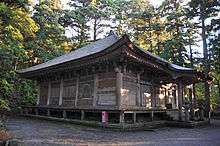Daisen-ji
Daisen-ji (大山寺, Daisen-ji) is a Buddhist temple in the town of Daisen, Tottori, Japan. The temple is built on the slopes of Daisen.[1] The Amida-dō and other parts of the temple are designated National Treasures of Japan.[2]
| Daisen-ji 大山寺 | |
|---|---|
 Amida-dō of Daisen-ji, Important Cultural Property of Japan | |
| Religion | |
| Affiliation | Tendai Buddhism |
| Deity | Jizō |
| Location | |
| Country | Japan |
| Geographic coordinates | |
| Architecture | |
| Completed | 718 |

History
Early history
Daisen, from early times, was considered a sacred mountain by practitioners of Koshintō, an early form of the Shinto religion.[2] By the 7th century the area became a center of shugendō, a syncretic religion which incorporated aspects Koshintō, Japanese folk animism and shamanism, Taoism and esoteric Buddhism of the Shingon Mikkyō and the Tendai sects.[3] After the 9th century, this temple came under the control of the Tendai Buddhist sect as one of the most important of its centers in this region. The head monk, or Zashu, of this temple had been sent from the Enryaku-ji in Kyoto, the headquarters of Tendai sect.
Modern history
Daisen-ji was greatly affected by the anti-Buddhist haibutsu kishaku movement (1868-c.1874) after the Meiji Restoration in 1868. Daisen-ji was closed in 1875. The Daichimyōkogen hall became the Ōgamiyama Shrine, and the Shinto-related assets of Daisen-ji were removed and transferred to the shrine. Daisen-ji was allowed to reopen in 1903.[1] In 1928 the Dainichi-dō was destroyed by fire. Numerous cultural treasures were lost in the fire, notably the Daisen-ji engi emaki, the illustrated scrolls of the history of the temple. The Dainichi-dō was reconstructed in 1951.[2]
Main Objects of Worship
- Juichimen-Kannon
- Amida Nyorai
Cultural Properties
This temple has the following Important Cultural Properties selected by Japanese government:
- The Amida Hall (Constructed in 1592)
- The three Amida divinities
- Juchimen-Kannon of Bronze
- Two Kannon-Bosatsu (one from the 8th century, the other made in China in the 12th century)
- The iron Buddhist altar
Access
- Daisen-ji Bus Stop of Nihon Kotsu
See also
- For an explanation of terms concerning Japanese Buddhism, Japanese Buddhist art, and Japanese Buddhist temple architecture, see the Glossary of Japanese Buddhism.
External links
- (in Japanese) Official Home Page of Daisen Tourist Bureau
References
- "Daisen-ji". Dijitaru daijisen (in Japanese). Tokyo: Shogakukan. 2012. Archived from the original on August 25, 2007. Retrieved 2012-04-14.
- "Daisen-ji". Nihon Rekishi Chimei Taikei (in Japanese). Tokyo: Shogakukan. 2012. Archived from the original on August 25, 2007. Retrieved 2012-05-20.
- "Shugendō". Encyclopedia of Japan. Tokyo: Netto Adobansusha. 2012. Archived from the original on August 25, 2007. Retrieved 2012-02-22.